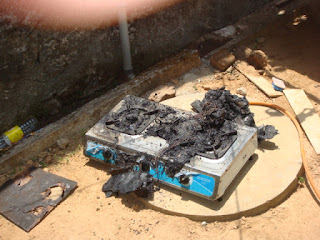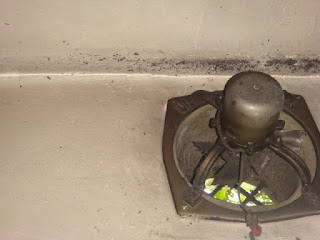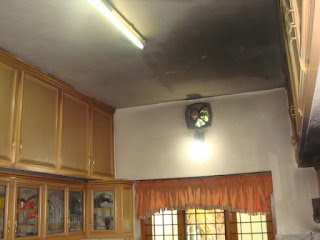It is now very common to have Kitchen
hood installed in at our home. Time has changed and with more modern amenities
we have to be additional cautious. I am writing this from a recent personal
accident that happened within our family. A fire incident that happened, and by
sheer luck those involved survived without any injury. The trauma that followed
still continues with family including adults and children. It is indeed an eye
opener. What do we do to avoid such incidents to recur?.
Indeed, Kitchen Safety should be
given high importance.
In kitchens, where deep fat fryers, special
baking appliances, tilting-type frying pans, broilers and grills are in use,
spontaneous fires must be expected. The chances are more common within Indian
families, who use more oil and frying methods while cooking.
Therefore, if you have installed a
Kitchen hood, it has to be cleaned.
Clean fire hoods prevent potentially dangerous
particulates from escaping into the air, lowering the air quality and
potentially posing a health hazard to all those involved. Therefore, If a kitchen installed with a
kitchen hood is found with a dirty hood, all efforts should be done to clean
and maintain it at the earliest to avoid potentially dangerous situation that
may happen.
Practice
kitchen safety.
Unattended cooking is a common
fire-starter, whether you are using a range or a microwave oven. If small
children are home, maintain a kids-free-zone of at least 3 feet and use back
burners when possible. Unplug small appliances, including toasters and
coffeemakers, when they are not in use or you are away for long periods.
Clean
range hoods.
Grease build up in range hoods is
another fire hazard, so be sure to clean the vents regularly.
Keep dryer
vents clear.
Clean your dryers lint screen regularly
to avoid lint build up, which was listed as a factor in many fires. Use rigid
metal dryer ducts instead of flexible ducts made of foil or plastic, which can
sag and let lint build. And check them regularly to remove any lint build up.
Stay in the
kitchen when using the range for cooking.
If you are leaving for just a minute,
turn off all the burners on the range. Going for a can of tomatoes, or running
out to check the mail, going to the bathroom, answering the phone in another
part of the house? Simply turn off all the burners. After all, you are just
leaving for a minute. You can immediately turn the pot or frying pan back on
when you return.
Taking this simple step will prevent
one of the most common situations that cause house fires due to unattended
cooking.
When cooking with oil, keep a lid or
flat cookie sheet close by. If flames appear, simply suffocate the fire with
the lid and immediately turn off the stove or fryer to let it cool down. Do not
try to move the pan. Do not use water. The super-heated water will explode into
steam, and can cause severe burns, and oil can splash and spread the fire.
Don't cook when drinking alcohol,
using drugs, or very tired. Eat something prepared, make a cold sandwich, and
go to sleep. Cook your meal later, when you are fully conscious.
Check stove vent hoods, clean the
filter regularly, and make sure that if it is equipped with an exterior vent,
insects or birds do not build nests or otherwise impede the air flow through
it.
Please ensure to employ a maintenance
team with quality professional service who can provide grease trap cleaning,
free waste oil removal, filter exchanges and hood fabrication as well as
accessory services such as hinge kits, access panels and grease containment
systems.
Each cleaning should include Filters,
Fans, inside and out, Accessible Ducts from top to bottom, Fire Suppression
Links, pipes and nozzles, detailed polish of all stainless steel exposures in
the hood interior.
In essence, maintain kitchen safety thanks to
a clean extractor hood
Measures for
a Safe Extractor Hood
If you want your extractor hood to be
safer and more efficient, you must clean the casing, inside and the filters,
which are usually removable, regularly. The frequency with which it must be
cleaned and maintained will depend on the use you give it and the type of
cooking you do.
The efficiency and safety of an
extractor hood are linked to its cleanliness and maintenance, for if the
appliance is dirty, the fans have a lower output and consume more energy in
order to perform the same function.
The energy consumption of this
electrical appliance fluctuates between 70w/h and 125w/h for the minimum power
(depending on the model) and 200w/h and 350w/h at maximum power.
Dirt
increases the risk of fire
The accumulated grease in the filters
increases the risk of fire, which may start with a flame from a frying pan or
by the burners overheating; this grease, on catching alight, will start the
fire.
The more you
fry, the more you need to clean
If you use your extractor hood a lot
and do a lot of frying, you must clean the casing, interior and removable
filters once a week. With fat-free recipes (boiling and steaming) the dirt
reduces, as such it is sufficient to clean it once every two or three weeks.
The safe
method, step by step
Switch the appliance off at the
mains, remove the filters, clean the inside of the appliance using a cloth that
has been dipped in soapy water and liquid ammonia, and dry it well using a cotton
cloth that does not leave fluff behind. Try not to touch the engine or fans.
Continue
with the casing
How you clean the casing depends on
the material that it is made from. If it is plastic you can use soapy water and
liquid ammonia, but if it is made of stainless steel, it is recommendable that you use a specific product which
polishes the steel. Never use this cleaner for the control panel, which will
come perfectly clean using the solution that is acceptable for the plastic
casing, but rinsing out the cloth completely.
Removable
filters keep it like new
The best way of cleaning them
involves placing them in a large bucket containing soapy water and liquid
ammonia and scrubbing them with a brush used only for that purpose. Then you
rinse them with clean water and leave them to dry outside. If it is sunny in
your utility room or balcony, hang them up there. You can also put them in the
dishwasher, placing them as vertically as possible in the lower shelf. If the
filters of your extractor hood are disposable, replace them with new ones as
often as the manufacturer’s instructions state.
In the event
of excessive dirt
If the removable filters and the
structure in which they are inserted are excessively dirty, apply an effective
grease remover to both parts, leave it to take effect for five minutes, and
then wipe the surface of the hood with a sponge, and scrub the filters with a
brush, until you remove all of the grease. Remember that dirt increases the
risk of a fire.
Did you know
that…
The majority of domestic fires start
in the kitchen, and especially in the extractor hood.
Get going, and have a look at your Kitchen hood and if you find it to be cleaned, do not delay.
Safety First, at all times.
Ramesh Menon, Abu Dhabi
Sunday, 12th May 2013
More photos:
Illustration
of dirt and grease accumulation that can turn potentially dangerous and turn in
to fire incident:


.gif)










Not all fire extinguishers are made for kitchen emergencies. Read on to find out which one will work best for you and keep your family safe.
ReplyDeleteFire Extinguisher Training in Las Vegas